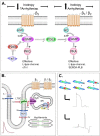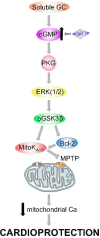Phosphodiesterase-5 inhibitors and the heart: compound cardioprotection?
- PMID: 29519873
- PMCID: PMC6204975
- DOI: 10.1136/heartjnl-2017-312865
Phosphodiesterase-5 inhibitors and the heart: compound cardioprotection?
Abstract
Novel cardioprotective agents are needed in both heart failure (HF) and myocardial infarction. Increasing evidence from cellular studies and animal models indicate protective effects of phosphodiesterase-5 (PDE5) inhibitors, drugs usually reserved as treatments of erectile dysfunction and pulmonary arterial hypertension. PDE5 inhibitors have been shown to improve contractile function in systolic HF, regress left ventricular hypertrophy, reduce myocardial infarct size and suppress ischaemia-induced ventricular arrhythmias. Underpinning these actions are complex but increasingly understood cellular mechanisms involving the cyclic GMP activation of protein kinase-G in both cardiac myocytes and the vasculature. In clinical trials, PDE5 inhibitors improve symptoms and ventricular function in systolic HF, and accumulating epidemiological data indicate a reduction in cardiovascular events and mortality in PDE5 inhibitor users at high cardiovascular risk. Here, we focus on the translation of underpinning basic science to clinical studies and report that PDE5 inhibitors act through a number of cardioprotective mechanisms, including a direct myocardial action independent of the vasculature. We conclude that future clinical trials should be designed with these mechanisms in mind to identify patient subsets that derive greatest treatment benefit from these novel cardioprotective agents.
Keywords: cardiac arrhythmias and resuscitation science; cardiac risk factors and prevention; coronary artery disease; heart failure; myocardial disease basic science.
© Article author(s) (or their employer(s) unless otherwise stated in the text of the article) 2018. All rights reserved. No commercial use is permitted unless otherwise expressly granted.
Conflict of interest statement
Competing interests: None declared.
Figures





References
Publication types
MeSH terms
Substances
Grants and funding
LinkOut - more resources
Full Text Sources
Other Literature Sources
Medical
Research Materials
Miscellaneous
